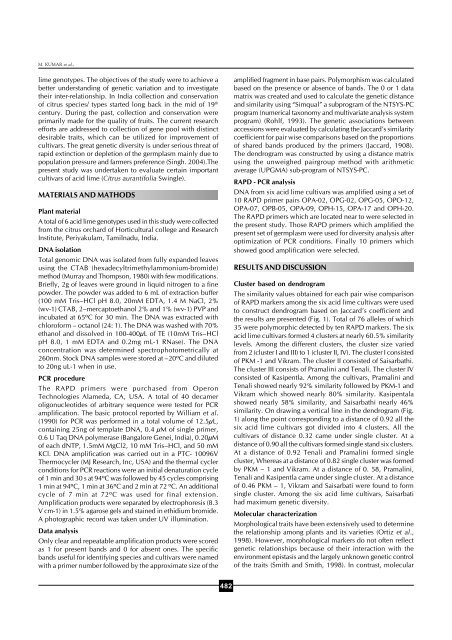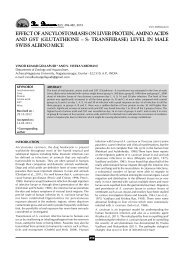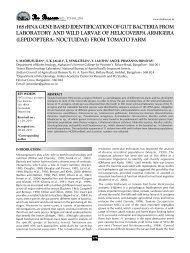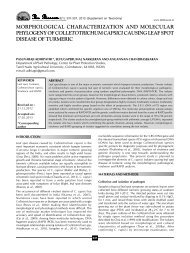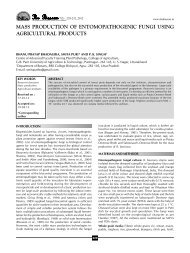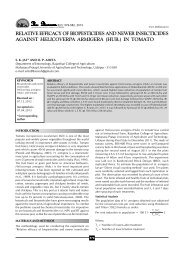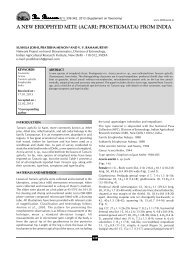Genetic diversity analysis of acid lime (Citrus ... - THE BIOSCAN
Genetic diversity analysis of acid lime (Citrus ... - THE BIOSCAN
Genetic diversity analysis of acid lime (Citrus ... - THE BIOSCAN
You also want an ePaper? Increase the reach of your titles
YUMPU automatically turns print PDFs into web optimized ePapers that Google loves.
M. KUMAR et al.,<strong>lime</strong> genotypes. The objectives <strong>of</strong> the study were to achieve abetter understanding <strong>of</strong> genetic variation and to investigatetheir inter-relationship. In India collection and conservation<strong>of</strong> citrus species/ types started long back in the mid <strong>of</strong> 19 thcentury. During the past, collection and conservation wereprimarily made for the quality <strong>of</strong> fruits. The current researchefforts are addressed to collection <strong>of</strong> gene pool with distinctdesirable traits, which can be utilized for improvement <strong>of</strong>cultivars. The great genetic <strong>diversity</strong> is under serious threat <strong>of</strong>rapid extinction or depletion <strong>of</strong> the germplasm mainly due topopulation pressure and farmers preference (Singh. 2004).Thepresent study was undertaken to evaluate certain importantcultivars <strong>of</strong> <strong>acid</strong> <strong>lime</strong> (<strong>Citrus</strong> aurantifolia Swingle).MATERIALS AND MATHODSPlant materialA total <strong>of</strong> 6 <strong>acid</strong> <strong>lime</strong> genotypes used in this study were collectedfrom the citrus orchard <strong>of</strong> Horticultural college and ResearchInstitute, Periyakulam, Tamilnadu, India.DNA isolationTotal genomic DNA was isolated from fully expanded leavesusing the CTAB (hexadecyltrimethylammonium-bromide)method (Murray and Thompson, 1980) with few modifications.Briefly, 2g <strong>of</strong> leaves were ground in liquid nitrogen to a finepowder. The powder was added to 6 mL <strong>of</strong> extraction buffer(100 mM Tris–HCl pH 8.0, 20mM EDTA, 1.4 M NaCl, 2%(wv-1) CTAB, 2–mercaptoethanol 2% and 1% (wv-1) PVP andincubated at 65ºC for 30 min. The DNA was extracted withchlor<strong>of</strong>orm – octanol (24: 1). The DNA was washed with 70%ethanol and dissolved in 100-400µL <strong>of</strong> TE (10mM Tris–HClpH 8.0, 1 mM EDTA and 0.2mg mL-1 RNase). The DNAconcentration was determined spectrophotometrically at260nm. Stock DNA samples were stored at –20ºC and dilutedto 20ng uL-1 when in use.PCR procedureThe RAPD primers were purchased from OperonTechnologies Alameda, CA, USA. A total <strong>of</strong> 40 decameroligonucleotides <strong>of</strong> arbitrary sequence were tested for PCRamplification. The basic protocol reported by William et al.(1990) for PCR was performed in a total volume <strong>of</strong> 12.5µL,containing 25ng <strong>of</strong> template DNA, 0.4 µM <strong>of</strong> single primer,0.6 U Taq DNA polymerase (Bangalore Genei, India), 0.20µM<strong>of</strong> each dNTP, 1.5mM MgCl2, 10 mM Tris–HCl, and 50 mMKCl. DNA amplification was carried out in a PTC- 10096VThermocycler (MJ Research, Inc, USA) and the thermal cyclerconditions for PCR reactions were an initial denaturation cycle<strong>of</strong> 1 min and 30 s at 94ºC was followed by 45 cycles comprising1 min at 94ºC, 1 min at 36ºC and 2 min at 72 ºC. An additionalcycle <strong>of</strong> 7 min at 72ºC was used for final extension.Amplification products were separated by electrophoresis (8.3V cm-1) in 1.5% agarose gels and stained in ethidium bromide.A photographic record was taken under UV illumination.Data <strong>analysis</strong>Only clear and repeatable amplification products were scoredas 1 for present bands and 0 for absent ones. The specificbands useful for identifying species and cultivars were namedwith a primer number followed by the approximate size <strong>of</strong> theamplified fragment in base pairs. Polymorphism was calculatedbased on the presence or absence <strong>of</strong> bands. The 0 or 1 datamatrix was created and used to calculate the genetic distanceand similarity using “Simqual” a subprogram <strong>of</strong> the NTSYS-PCprogram (numerical taxonomy and multivariate <strong>analysis</strong> systemprogram) (Rohlf, 1993). The genetic associations betweenaccessions were evaluated by calculating the Jaccard’s similaritycoefficient for pair wise comparisons based on the proportions<strong>of</strong> shared bands produced by the primers (Jaccard, 1908).The dendrogram was constructed by using a distance matrixusing the unweighed pairgroup method with arithmeticaverage (UPGMA) sub-program <strong>of</strong> NTSYS-PC.RAPD - PCR <strong>analysis</strong>DNA from six <strong>acid</strong> <strong>lime</strong> cultivars was amplified using a set <strong>of</strong>10 RAPD primer pairs OPA-02, OPG-02, OPG-05, OPO-12,OPA-07, OPB-05, OPA-09, OPH-15, OPA-17 and OPH-20.The RAPD primers which are located near to were selected inthe present study. Those RAPD primers which amplified thepresent set <strong>of</strong> germplasm were used for <strong>diversity</strong> <strong>analysis</strong> afteroptimization <strong>of</strong> PCR conditions. Finally 10 primers whichshowed good amplification were selected.RESULTS AND DISCUSSIONCluster based on dendrogramThe similarity values obtained for each pair wise comparison<strong>of</strong> RAPD markers among the six <strong>acid</strong> <strong>lime</strong> cultivars were usedto construct dendrogram based on Jaccard’s coefficient andthe results are presented (Fig. 1). Total <strong>of</strong> 76 alleles <strong>of</strong> which35 were polymorphic detected by ten RAPD markers. The six<strong>acid</strong> <strong>lime</strong> cultivars formed 4 clusters at nearly 60.5% similaritylevels. Among the different clusters, the cluster size variedfrom 2 (cluster I and III) to 1 (cluster II, IV). The cluster I consisted<strong>of</strong> PKM -1 and Vikram. The cluster II consisted <strong>of</strong> Saisarbathi.The cluster III consists <strong>of</strong> Pramalini and Tenali. The cluster IVconsisted <strong>of</strong> Kasipentla. Among the cultivars, Pramalini andTenali showed nearly 92% similarity followed by PKM-1 andVikram which showed nearly 80% similarity. Kasipentalashowed nearly 58% similarity, and Saisarbathi nearly 46%similarity. On drawing a vertical line in the dendrogram (Fig.1) along the point corresponding to a distance <strong>of</strong> 0.92 all thesix <strong>acid</strong> <strong>lime</strong> cultivars got divided into 4 clusters. All thecultivars <strong>of</strong> distance 0.32 came under single cluster. At adistance <strong>of</strong> 0.90 all the cultivars formed single stand six clusters.At a distance <strong>of</strong> 0.92 Tenali and Pramalini formed singlecluster, Whereas at a distance <strong>of</strong> 0.82 single cluster was formedby PKM – 1 and Vikram. At a distance <strong>of</strong> 0. 58, Pramalini,Tenali and Kasipentla came under single cluster. At a distance<strong>of</strong> 0.46 PKM – 1, Vikram and Saisarbati were found to formsingle cluster. Among the six <strong>acid</strong> <strong>lime</strong> cultivars, Saisarbatihad maximum genetic <strong>diversity</strong>.Molecular characterizationMorphological traits have been extensively used to determinethe relationship among plants and its varieties (Ortiz et al.,1998). However, morphological markers do not <strong>of</strong>ten reflectgenetic relationships because <strong>of</strong> their interaction with theenvironment epistasis and the largely unknown genetic control<strong>of</strong> the traits (Smith and Smith, 1998). In contrast, molecular482


